Remember the leftover afghan I started about a month ago?
It’s coming along. The blue section is growing nicely, and I’ve made some progress on the red section too. I went on a road trip to DC last weekend, and was working on the red section in the car.
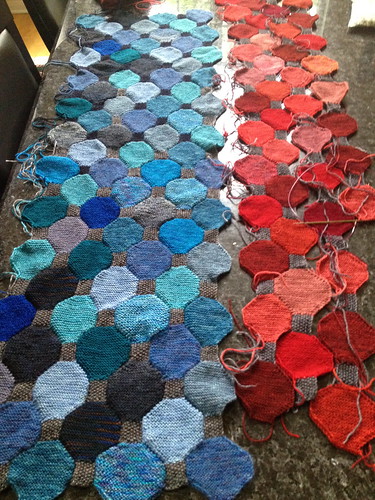
Now that cottage season is almost upon us, I think I need to get a little further on this blanket so I have a chance to use it before fall.
In what’s a rather exciting development, the Ranrike Shawl hit the nr 2 spot on “What’s hot right now” on Ravelry.
Thank you everyone who made that happen – that’s so exciting.
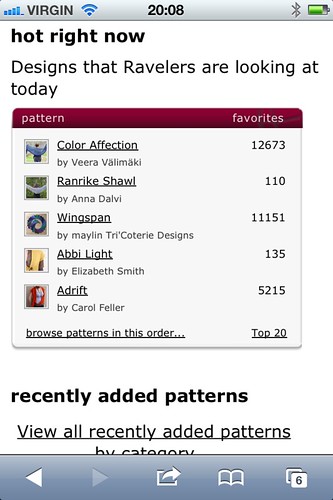
I hope you’ll join in for the KAL running now until June 6 (as in cast on before that date – keep knitting as long as you’d like).
To sign up, you can get the pattern here, and then join the fun in my Ravelry group.
In Ancient Egypt, colour was a very important part of the arts and life. There were six basic colours – green, red, white, black, yellow and blue – and each colour symbolized different aspects of the world and life.
There are twelve new shawl patterns in the book – two in each colour. The book explains the symbolic meaning of each of the colours in ancient Egyptian culture. And each pattern is inspired by a story from ancient Egyptian mythology and culture.
The book will be published this summer (2012) with Cooperative Press and is now available for preorder.
In Lokasenna (Loki’s quarrel) in the Poetic Edda, Ægir had invited the gods for a feast at which he served home-brewed ale. Ægir and his daughters had brewed the ale in a giant cauldron. Ægir’s servants welcomed the guests. Many of the gods were there, but not Thor because he was in Jotunheim. Bright gold lit the hall, cups filled themselves with ale, and the place was peaceful. Many of the guests praised Ægir’s servants. Loki could not bear that and killed one of the servants. The gods were angered and chased him into the forest, and then returned to their drinking.
Later, Loki returned and found one of the other servants outside. He asked what the gods were talking about at the feast, and was told that they were discussing their weapons and their great skill at war, and that Loki was not welcome. But Loki entered anyhow and demanded a seat. Bragi (the god of poetry) says that the gods will refuse to make room for Loki at the feast, but Loki then called on Odin and reminds him that long ago when Loki and Odin blended blood, Odin vowed that they would always drink together. Odin asks his son Vidar to give up his seat for Loki and pour him some ale. But before Loki drank, he toasted the gods and pointedly excludes Bragi. Bragi offered him a sword, a horse and gold to placate him, but Loki insulted his courage, and then proceeded to insult the other gods present. Insults were traded back and forth until Thor arrived and threatened Loki four times to be quiet or the might of Mjölnir would break every bone in Loki’s body. Loki then states that he had said what he wanted to the gods, but now he would leave, as he was convinced that Thor would kill.
Loki left and hid in the Franang waterfall, but there he was captured by the gods and bound with the guts of his son beneath a poisonous snake. Sigun, Lokis’s wife, sat there beside him holding a bowl which caught the venom that dripped down. But when the bowl was full, she had to carry it outside, and meanwhile the venom dripped on Loki. Then he struggled so hard that the whole earth shook, and that is what people now call earthquakes.
Ægir was cursed by Loki that he would never again hold a feast in his hall. “May all that is here, everything you own, fall to the flames and drag you down with it!”
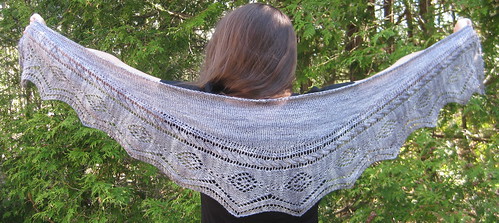
To join the Ranrike KAL and knit the Ranrike Shawl, sign up here.
Rán is the old Norse Goddess of the sea. She was married to Ægir who is the god of the ocean and king of the sea creatures, and is thought to have been a giant. Rán and Ægir had nine daughters known as the billow maidens.
Ægir apparently had a lot of cauldrons in which to brew ale, and the gods decided that because of that, he should be their host from know on. Ægir agrees, but on the condition that they bring him a cauldron large enough to warm the ale for everyone. Tyr remembers that Hymir owns such a large cauldron, and they set out to retrieve it. When they find Hymir’s abode, Thor eats so much that Hymir and his guests must go fishing. Thor almost the Jörmugandr (the Midgard Serpent) and boasts of his strength, but Hymir says that Thor can’t be very strong if he can’t even break Hymir’s chalice. The chalice was magic, and try as he might, Thor could not break it. Then a giant’s mistress told Thor to throw it at Hymir’s head, since that would break the spell. The chalice cracked, and Hymir allowed the gods to take the cauldron to Ægir. Thanks to this, the gods would now drink ale brewed by Ægir’s fire and hold feasts there.
Even today, giant cauldrons can be found in the granite of Ranrike. They are giant holes drilled into the granite shield.

The giant cauldrons were formed during the ice age, when boulders, rocks or pebbles were caught in eddies under the moving glaciers and drilled into the granite over time.

To join the Ranrike KAL and knit the Ranrike Shawl, sign up here.
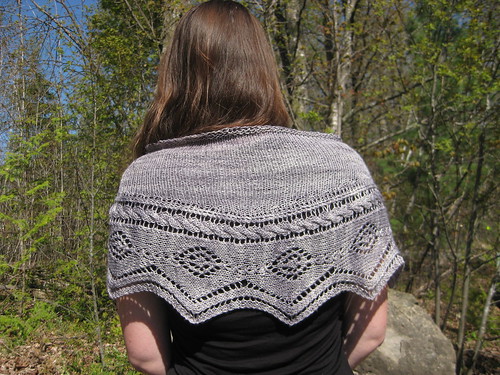
Time to return (knitting-wise) to my roots. Ranrike is the old Norse name for what is now the area around the Oslofjord in Norway and northern Bohuslän in Sweden. The name comes from Rán – the old norse goddess or the sea – and refers to her kingdom.

Ranrike is famous for its rocky landscape and granite cliffs. And I’ve spent every childhood summer exploring the rocky landscape, hiding in caves or diving off cliffs.
The Ranrike Shawl is a crescent shaped shawl knit in a single ply fingering weight yarn from Zen Yarn Garden. The shawl can be knit in three different sizes.
Small: Wingspan: 48 in [122 cm] Height: 14 in [36 cm]
Medium: Wingspan: 60 in [152 cm] Height: 15.5 in [39 cm]
Large: Wingspan: 72 in [184 cm] Height: 17 in [43 cm]
1 skein will be enough for the small shawl, but for the medium or large size you’ll need 2 skeins.
The pattern will be available at a special introductory price of $5.00 CDN until June 6.

If you post a cast-on picture between now and then on your Ravelry project page (and link the project to Ranrike Shawl so I can find it), you are eligible to win a PDF copy of Ancient Egypt in Lace & Color – that is my upcoming book with 12 lace shawl designs inspired by Ancient Egyptian mythology (published summer 2012 with Cooperative Press).


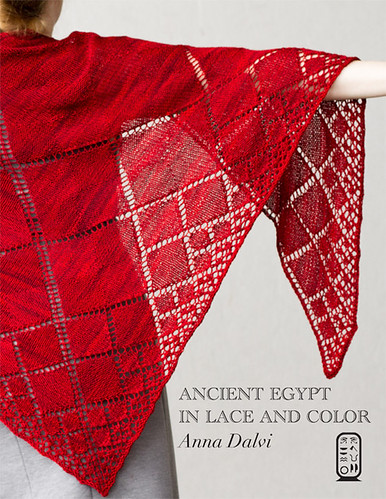

Recent Comments